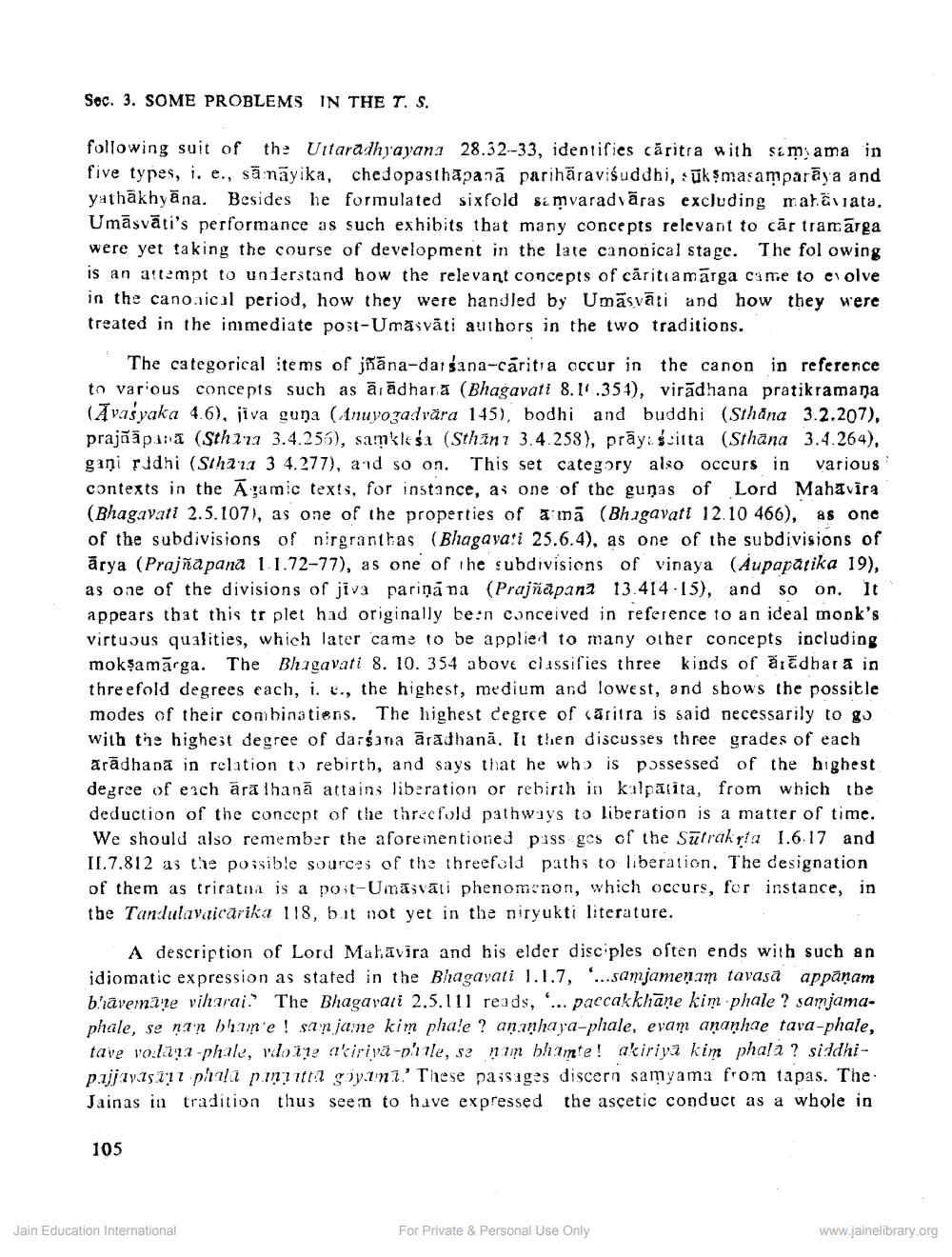________________
Sec. 3. SOME PROBLEMS IN THE T. S.
following suit of the Uttaradhyayana 28.32-33, identifies caritra with simsama in five types, i. e., sā nāyika, chedopasthapanā parihäravisuddhi, ūksmasamparāya and yathākhyāna. Besides he formulated sixfold simvaradıāras excluding mahäviata. Umāsvāti's performance as such exhibits that many concepts relevant to cār tramárga were yet taking the course of development in the late canonical stage. The fol owing is an attempt to understand how the relevant concepts of caritiamārga came to ci olve in the canoaical period, how they were handled by Umāsvāti and how they were treated in the immediate post-Umāsvāti authors in the two traditions.
The categorical items of jñāna-darsana-caritra occur in the canon in reference to various concepts such as ārādhara (Bhagavati 8.11.354), viradhana pratikramana (Avasyaka 4.6), jiva guna (Anuyogadvära 145), bodhi and buddhi (Sthana 3.2.207), prajñāpa: a (Sthina 3.4.256), samklesa (Sthani 3.4.258), prāy: Ścita (Sthana 3.4.264), gani pidhi (Stha 11 3 4.277), and so on. This set category also occurs in various contexts in the Āzamic texts, for instance, as one of the guņas of Lord Mahavira (Bhagavati 2.5.107), as one of the properties of a mä (Bhagavati 12.10 466), as one of the subdivisions of nirgranthas (Bhagavati 25.6.4), as one of the subdivisions of ārya (Prajña pana 1.1.72-77), as one of he subdivisions of vinaya (Aupapărika 19), as one of the divisions of jiva pariņāna (Prajñāpana 13.414-15), and so on. It appears that this tr plet had originally be?n conceived in reference to an ideal monk's virtuous qualities, which later came to be applied to many other concepts including mokşamārga. The Bhagavati 8. 10. 354 above classifies three kinds of aadhara in threefold degrees each, i. t., the highest, medium and lowest, and sbows the possible modes of their combinatiens. The highest degree of caritra is said necessarily to go with the highest degree of darśana āradhana. It then discusses three grades of each arādhana in relation to rebirth, and says that he who is possessed of the highest degree of each ārā ihanā attains liberation or rebirth in kalpatita, from which the deduction of the concept of the threefold pathways to liberation is a matter of time. We should also remember the aforeinentioned pass ges of the Sufrakra 1.6.17 and 11.7.812 as the possible sources of the threefold paths to liberation. The designation of them as triratna is a poit-Umāsvāli phenomenon, which occurs, for instance, in the Tandulavaicārika 118, but not yet in the niryukti literature.
A description of Lord Malāvira and his elder disciples often ends with such an idiomatic expression as stated in the Bhagayati 1.1.7, ....samjamenım tavasa appāņam b'avemane vihai.' The Bhagavati 2.5.111 reads, ... paccakkhāne kim phale ? samjamaphale, se non blu.ne! sanjarne kim phale ? anınhaya-phale, evam aņaņhae tava-phale, tave volana-phile, vdoine akiripa-pale, sa nun bhante! akiriya kim phala ? siddhipajj av.ts 217 phila p iitta guy.lini.' These passages discern samyama from tapas. The Jainas in tradition thus seen to have expressed the ascetic conduct as a whole in
105
Jain Education International
For Private & Personal Use Only
www.jainelibrary.org




